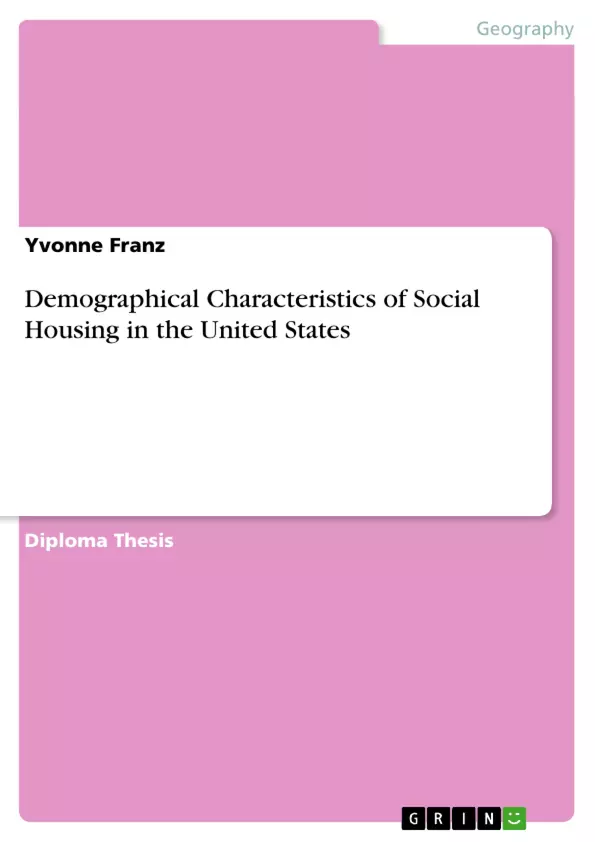This thesis focuses on the demographical characteristics of social housing in the United States. At the beginning, a comprehensive overview about the system of the housing market itself and the development of social housing in the United States is given by observing the current situation in the United States and in New York City in particular. After gathering this information, the demographical characteristics of social housing tenants are elaborated in more detail. The main objective is to study and evaluate demographical developments, status quo and current challenges. At the end, a critical evaluation of the social housing system and its tenants in the United States is possible from a present-day perspective, as well as for the future.
Inhaltsverzeichnis (Table of Contents)
- Theory of Housing Market and Social Housing
- Meaning of Housing Market
- Actors of the Housing Market and Their Interactions
- Processes of Housing Market
- Market Behaviour
- Social Housing
- Defining Social Housing
- Supply Side of the Social Housing Market
- Demand Side of the Social Housing Market
- Role of Social Housing in Europe and the United States
- Meaning of Housing Market
- Development of Social Housing in the United States
- Summary of the Historical Development
- Period Before World War I
- Interwar Period
- Post World War II
- Reagan Period
- Current Situation
- The Current Social Housing System of the United States
- Institutions
- Non-Profit Organizations
- Housing Eligibility and Accessibility
- Demographics of Social Housing Residents in the USA
- Migration and Diversity
- Current Situation of Social Rent Household
- Householder Characteristics
- Household Characteristics
- Summary of the Historical Development
- Case Study New York City
- Current Structure of the City
- Variation of Economical Data
- Variation of Demographical Data
- Situation of Social Housing in New York City
- The New York City Housing Authority
- The New York Department of Housing Preservation and Development
- Demographics of Social Housing Residents in New York City
- Ethnic Origin
- Household Composition
- Distribution of Age
- Socio-Economic Status
- Second Generation in New York City
- Demographic Overview of the Second Generation
- Geographic Characteristics of the Second Generation in New York
- Housing Accessibility and Affordability in New York City
- Future Challenges of Social Housing in New York City
- Crisis of New York City Housing Authority
- Financial Crisis of the United States
- Current Structure of the City
- Critical Evaluation of the Social Housing System of the United States and its Residents
- Social Housing in the United States
- Demographical Characteristics: Social Housing Only for Marginalized Population?
- Future Prospects
Zielsetzung und Themenschwerpunkte (Objectives and Key Themes)
This text aims to provide a comprehensive overview of the social housing market in the United States, with a particular focus on New York City. It explores the historical development of social housing, examines the current system and its actors, and analyzes the demographics and challenges faced by social housing residents.
- The complexities of the housing market and its relation to social housing.
- The historical development of social housing in the United States, including its changing role and challenges.
- The demographics and characteristics of social housing residents, including their migration patterns and socioeconomic status.
- The challenges facing social housing systems in the United States, including financial constraints and the needs of the second generation.
- The future prospects for social housing in the United States and its implications for residents.
Zusammenfassung der Kapitel (Chapter Summaries)
Chapter 1 introduces the theoretical framework for understanding the housing market and social housing. It defines the housing market, explores its actors and interactions, and discusses the supply and demand dynamics. This chapter also examines the specific features and role of social housing, differentiating it from the broader housing market.
Chapter 2 delves into the historical development of social housing in the United States. It analyzes key periods such as the pre-World War I era, the interwar period, the post-World War II era, the Reagan era, and the current situation. This chapter also examines the current social housing system, including its institutions, non-profit organizations, and eligibility criteria. The demographics of social housing residents are explored, including migration patterns, household characteristics, and the current situation of social rent households.
Chapter 3 presents a case study of New York City, examining the city's current economic and demographic landscape. It explores the structure of social housing in New York City, focusing on the New York City Housing Authority and the New York Department of Housing Preservation and Development. This chapter further investigates the demographics of social housing residents in New York City, including their ethnic origins, household composition, age distribution, and socioeconomic status. The second generation in New York City is also explored, analyzing its demographic overview and geographic characteristics. The chapter concludes by examining housing accessibility and affordability in New York City and highlighting the future challenges facing social housing in the city, including the crisis facing the New York City Housing Authority and the impact of the financial crisis in the United States.
Schlüsselwörter (Keywords)
This work explores the multifaceted nature of social housing in the United States, particularly within the context of New York City. Key concepts include the housing market, supply and demand dynamics, social housing systems, historical development, demographics, household characteristics, migration patterns, accessibility, affordability, and the challenges faced by both the system and its residents. The text also delves into the impact of financial crises and the changing needs of the second generation, offering insights into the complex interplay between social housing, urban development, and societal dynamics in the United States.
- Citar trabajo
- Yvonne Franz (Autor), 2009, Demographical Characteristics of Social Housing in the United States, Múnich, GRIN Verlag, https://www.grin.com/document/135945



